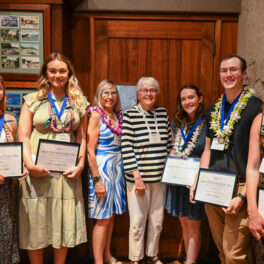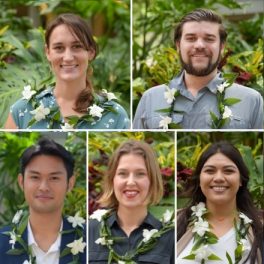More than 120 University of Hawaiʻi at Mānoa and UH Hilo researchers have been recognized among the world’s top scientists in multiple fields, including environmental science, Earth science, ecology and evolution, and more, according to the 2023 best university rankings by Research.com.
Impressively, two SOEST faculty members, atmospheric scientist Bin Wang and oceanographer David Karl, were named in the top 25 researchers internationally. Based on a meticulous examination of 166,880 scientists on Google Scholar and Microsoft Academic Graph, the rankings report on the impact of research published by scientists in 21 disciplines.
Wang and Karl were ranked among over 11,258 profiles in the Environmental Sciences discipline–placing them in the top 0.2% of researchers worldwide.
“These two world class scientists exemplify not only excellence in research and the search for truth, but also a thoughtful, caring, and nurturing attitude toward their students and colleagues,” said Chip Fletcher, interim dean of the UH Mānoa School of Ocean and Earth Science and Technology. “Bin and Dave are known far and wide as outstanding teachers and mentors who express a genuine kindness, a holistic love for our Earthly home, and a deep concern for the future of humanity. We are indeed blessed to know them as friends and collaborators.”
Bin Wang
Wang, ranked 11 internationally and 5 in the nation, is an emeritus professor who has been with the Department of Atmospheric Sciences (formerly Department of Meteorology) at UH Mānoa since 1987. He is a leading meteorologist specializing in climate and atmospheric dynamics. Among his research interests are variability and predictability of Asian-Australian monsoons, climate predictions, tropical cyclones and El Niño – Southern Oscillation dynamics. The ranking reported that Wang’s publications have more than 83,000 citations. Active in the science community, he has organized numerous international workshops and conferences and has been serving on scientific advisory committees in his field. Wang is among the most influential scientists in monsoon research worldwide and in development of meteorological sciences and climate predictions in Asian-Pacific region.
David Karl
Karl, ranked 22 in the world and 13 nationally, is the Victor and Peggy Brandstrom Pavel Professor of Microbial Oceanography and Director of the Daniel K. Inouye Center for Microbial Oceanography: Research and Education (C-MORE). As a microbial oceanographer, he has studied the distribution and metabolic activities of microorganisms at various sites in the global ocean from the equator to both poles and from the surface to the greatest ocean depths. In 1988, he co-founded the Hawaii Ocean Time-series program as a sentinel for observing the effects of climate on the structure and function of microbial communities. He has spent more than 1,000 days conducting research at sea including 23 expeditions to Antarctica. Karl’s research has centered around the ocean’s carbon cycle from photosynthetic production of organic matter to carbon sequestration in the deep sea. A member of the National Academy of Sciences, Karl’s publications continue to advance the field of microbial ecology and collectively have more than 61,000 citations, according to the new ranking report.
Additionally, numerous current faculty and emeritus professors ranked in the top 10% globally in the following disciplines:
Earth science
Fred T. Mackenzie
Fei-Fei Jin
Alexander N. Krot
Bruce F. Houghton
Michael O. Garcia
Christopher L. Sabine
Ecology and evolution
Brian W. Bowen
Craig R. Smith
Robert J. Toonen
Environmental Sciences
Tim Li
Antony D. Clark
Barry J. Huebert
Brian N. Popp
Yuqing Wang
UH Mānoa as a whole ranked in the nation’s top 30 in three subjects (Earth science No. 11, environmental sciences No. 21 and ecology and evolution No. 30).
The rankings by Research.com were compiled based on citations, publications and the Discipline H-index (D-index), which is a measure that reflects the number of influential documents authored by scientists and only includes publications and citation metrics for an examined discipline. Note: not all subjects are ranked every year.For a listing of additional UH faculty and discipline rankings, visit UH News.














